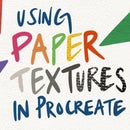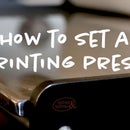Introduction: Print From a Recycled Carton
In this project I show you how to design and make drypoint prints using recycled cartons, hand coloured with drawing ink. I cover all the steps for making and printing a drypoint print using intaglio methods. Make sure to watch the video to see all the steps in action.
Supplies
Clean and dry juice or milk carton
Steel ruler
Cutting mat
Utility knife
Greasy pencil
Roulette wheel (I used an Arteina interchangeable intaglio tool set)
Drypoint nib (or other pointy tool; you could use a nail or a ballpoint pen, for example)
Etching ink (I used a mix of Charbonnel F66 and 55981)
Perspex, glass or tile to use as an inking slab
Paint/ink knife
Small piece of rubber, eraser or stiff cardboard for spreading ink
Tarlatan cloth/scrim
Phone book or newspaper
Latex type gloves
Printmaking paper suitable for intaglio (I used Zerkall 120gsm laid etching paper)
Wet sponge or water spray bottle
Ziplock bag or plastic container with lid
Etching press
Pasta machine etching press (alternative to etching press, see my instructable here: https://www.instructables.com/Mini-Pasta-Machine-... )
Etching press blankets (I used 1.5mm, 3mm and 6mm)
Citrus based brush cleaner
Cleaning gloves
Rag
Coloured drawing ink (or your choice of colouring medium)
Japanese goat hair ink brush
Newsprint paper
Paint scraper
Step 1: What Is a Drypoint?
Drypoint is a type of intaglio printing, but it’s one that you can do safely and easily at home. Traditionally drypoint has been done on a metal plate like copper, but it’s also possible to make drypoint plates using cardboard.
Drypoint prints use the intaglio method of printing, which is where ink sits in grooves on the surface of the plate and is transferred to your paper using the pressure or force from an etching press or a press made from a pasta machine.
Step 2: Making a Drypoint Plate Using a Recycled Cardboard Carton
Milk and juice cartons make the perfect material for drypoint as they’re already coated with a substance that makes them waterproof, so you don’t need to seal them before printing.
Began making your plate by slicing one of the panels off with a utility knife, cutting mat and ruler. I chose to cut the folds in the carton off for the print I’m making, but these will pick up ink in an interesting way, so if you want to incorporate them into your print, you can cut your carton in a way that includes them.
Grab a pencil that will draw on the carton surface. An oily pencil will work for this, like a lithographic pencil or a chinagraph pencil, or even an old eyeliner pencil, but you could also use a sharpie or marker. This drawing is just a guide for where you'll make indentations with some sharp tools on the surface of the carton.
You can use any type of pointy tool you like to press into the surface to make indentations in your carton. I started out with a roulette tool. The roulette wheel is covered in little raised dots, and I pushed this into the plate in areas that I wanted to print with a tone. All of the little dot indentations will collect ink, and it will give the impression of shading in the image when printed.
If you don’t have any specific printmaking tools at home, don’t worry, you can use any sharp or pointy object as your tool, like a nail or a ballpoint pen. If you can press it into the surface of the carton, you can use it as your tool.
When I was finished with the roulette tool, I swapped to a pointed drypoint nib for the linework. I traced over the areas that I want outlined, and also used the tool to do some hatching and crosshatching, reinforcing the areas of shading made earlier with the roulette wheel.
Step 3: Prepare and Soak Your Paper for Intaglio Printing
You’ll need to prepare your paper before you start printing, and with the method I use, it’s best to do it the night before you plan to print. The paper you use for intaglio printing needs to be damp when you run it through the press, so that it’s more flexible and can be pushed into the grooves on your plate to collect the ink more easily. You’ll need to use a type of art paper that can be soaked in water without falling apart. You’ll want to look for something soft but strong, and any paper that’s suitable for etching will work. For my prints, I used some scraps of Zerkall 120gsm etching and bookbinding paper, which I find works really well for this method. I started with some long strips of paper, made a pinch mark at the half way point for my measurement, and tore the paper in stacks in half and in half again, until the paper was the size I needed it to be.
The next step is to wet the paper down and leave it to soak. Spray each piece of paper with water from a spray bottle, then put them in a stack inside a plastic ziplock bag overnight. If you don’t have a spray bottle, you can wipe each piece of paper with a dampened cloth. This method of soaking your paper doesn’t use a lot of water, and it’s also less messy than some of the traditional ways of preparing your paper. It's perfect if you don’t have good access to running water in your workspace.
As always, experiment with different brands, weights and colours of paper to see what you like working with. Keep in mind that with this type of printing that you need to use the same kind of paper for your proofs and test prints as you’re using for your final edition, as substituting paper will give you different results. Prepare yourself a few more pieces of paper than you think you’ll need.
Step 4: Setting an Etching Press or Using a Pasta Machine to Print
I printed my drypoint prints on an etching press using three blankets, with the thinnest blanket the closest to the press bed and the thickest blanket closest to the top roller. The woollen blankets help push your paper into the grooves on your plate when you roll it through the press.
For this type of printing you need to set your press fairly tightly. You probably don’t have one of these at home unless you’re very, very lucky. If you want to print on a press, you might be able to use one in a local open access printmaking studio or university, but if you don’t have those types of facilities in your area, this type of drypoint printing is absolutely perfect for printing with a pasta machine press. You can find my Pasta Press instructable here if you want to build your own: https://www.instructables.com/Mini-Pasta-Machine-Etching-Press/
If you're making a bleed print, which means the paper is smaller than the printing plate, you'll need to tear down some sheets of clean newsprint paper to place over your plate/paper. The newsprint stops the extra ink from the edges of the plate transferring onto your press blankets.
Step 5: Inking Up a Drypoint Plate Using Intaglio Methods
When everything is set to go you can start inking up your plate. You may need to experiment with your ink as you do the first few prints. Etching ink comes in a wide variety of viscosities. Some ink will be looser and some will be stiffer, and different textures will work better for different kinds of prints. For my prints, I used some Charbonnel F66 black ink, which is quite stiff and creamy. It didn’t work super well for my image alone, so I mixed in some very loose Charbonnel 55981 and got an ink that was perfect. You can also modify your inks with different substances to adjust the texture, like linseed oil or magnesium carbonate powder.
To get your ink onto the plate, you can pick it up off your slab with an eraser, a piece of screen printing squeegee, a bit of stiff cardboard or an old plastic card, and you use this tool to wipe the ink across your image. The next step is to use a piece of bunched up tarlatan to wipe off some of the ink while also pushing it into the grooves on your plate. Tarlatan is a type of open weave cotton cheesecloth that’s been stiffened with glue. When you’ve wiped off as much ink as you can with the tarlatan, you can polish the ink off the surface of your plate with some pieces of paper torn out of an old phone book or newspaper. Keep your hand flat when you do this, as you just want to take ink off the surface of the plate. How much ink you take off the plate will depend entirely on your image, and you’ll need to experiment a bit with your first few prints to figure out the best wiping method. It’s a good idea to wear some thin disposable gloves when you’re inking up, as it can be a pretty messy process.
Step 6: Printing With an Etching Press
When you’re ready to print, just put your plate face up on the bed of your press, and put a piece of your dampened paper on top. If you can still see pools of water on the surface of your paper, blot this off gently with some newsprint first. The paper needs to be damp, but you don’t want it to be visibly wet. Place the paper carefully onto your plate and put down a sheet of clean newsprint on top if you need to. Lay your press blankets over the whole lot and run it through the press.
Step 7: Stacking Your Prints to Dry and Flatten Them at the Same Time
If you stack your prints as you make them, you can dry and flatten them in one go. To do this, put down a sheet of stiff cardboard, put a clean piece of newsprint on top, lay out your prints, and when the first layer is full, put another piece of clean newsprint down. Put a second piece of cardboard down and repeat the process until you’re done. Weigh down the last piece of cardboard with a book or some light weights for a day or two, and when you unstack them they’ll be dry and flat.
Step 8: Cleaning Up
Cleaning up properly is very important, especially if you’re using a shared or public studio space, but fortunately it’s also pretty straightforward. As I saw on a printmaking poster in an open access studio one day, "if you don't have time to clean up, you don't have time to print".
Clean the press bed with a rag and a little citrus based cleaner (this is healthier for your lungs, skin and the environment than turpentine, and also smells a lot better), then go over it again with a dry paper towel.
Clean the ink off your drypoint plate with the same rag and citrus cleaner, then scrape the excess ink off your slab with a paint scraper. Wipe this excess ink on the scraps of phonebook paper that you used earlier to polish your plate. Clean excess ink off your tools carefully with the paint scraper, and then collect all the rubbish together and wipe everything down with some citrus cleaner.
Step 9: Unstacking and Hand Colouring Your Prints
After they've been sitting for a day or two, carefully unstack your prints from between the cardboard and newsprint.
If you want to add colour to your prints, you can do it in pretty much any way you want. You can use coloured pencils, and watercolours also work well. I coloured my drypoint prints with some really vibrant drawing ink applied with a Japanese ink brush.
And that’s it! That’s how you can make a drypoint print with an old, recycled juice or milk carton.

Participated in the
Paper Contest













